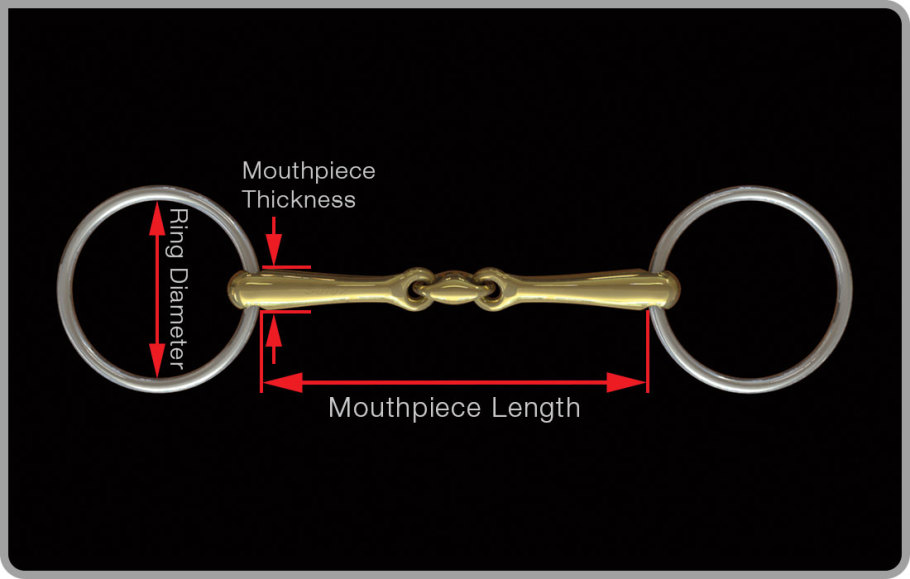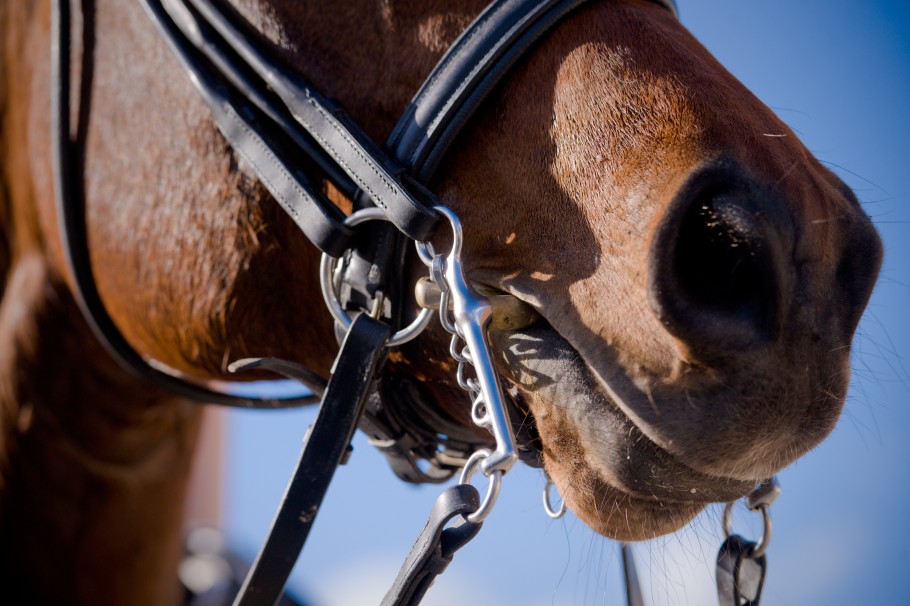Does My Horse’s Bit Fit?
Updated January 31, 2024

Have you ever wondered if you have the correct size horse bit or stared at the size options for the bit you’re about to order, hoping you are picking the right one? Stop guessing and learn easy ways to measure your horse for a bit size and assess it's fit in your horse’s mouth.
Importance of Bit Fit
Metal bits are thought to have been developed and used in riding sometime between 1300 and 1200 BC. Other materials, such as bone and wood, may have been used before that time, but non-metal materials were not as durable.
Selecting the correct horse bit size can significantly impact the effectiveness and your horse’s comfort. A bit that’s too-small can pinch and cause rubs on the tongue or cheeks, and a bits that’s too-big can slide around in the mouth and be less effective.
Understanding Horse Bit Sizes
Bits have several measurements:
- Length of the bit from one ring to the other is the main measure, displayed in inches or mm. Standard horse sizes include 5”, 5 ¼”, and 5 ½” (130mm, 135mm, 140mm.) Pony bits can run as small as 3”, and draft horses run as large as 7”.
- Mouthpiece thickness, typically 14mm to 18mm.
- Ring diameter or shank length.

Measuring Your Horse’s Mouth for a Bit
You can use one of several options to measure your horse’s mouth. You can measure the bit if you have a bit that you know fits well. Bits are measured from inside corner to inside corner, across the length of the horse’s mouth.
An alternative option is using a measuring tool, such as a dowel, string, or soft measuring tape, and marking both ends where the lips end. Make sure whatever you start to measure sits approximately where the bit will sit. You can measure between the marks once you remove the dowel or string from the horse’s mouth. Use a measuring tape that shows inches and metric cm/mm, as bit measurements can be in both.
Ensuring Proper Bit Fit

You can check for fit when the bit is attached to the bridle and in the horse’s mouth. Before checking the bit fit, ensure the bridle is adjusted so the bit is sitting at the right height in the horse’s mouth.
How should it look? For snaffle bits, you should see 1-2 wrinkles at the corner of the mouth and tension on the cheek pieces without solid pressure. You won’t see any wrinkles for curb bits, but the bit should be resting against the corners of the horse’s mouth and should not be low enough to touch or bang on the teeth.
Assessing Width of the Horse Bit
Once the bit sits properly in the horse’s mouth, you can assess the width. Does it feel tight on the sides of the mouth, with little to no room to move the bit from side to side? If so, it may be too narrow.
Ideally, you want 1/8” to 1/4” of space on either side of the horse’s mouth, but this depends on how fleshy your horse’s lips are. Some horses have a lot of lip, so there will still be a lot of side-to-side movement, even if the lips touch the bit cheekpieces or rings. Other horses have very firm lips so that you can see the space.
If you can easily slide the bit back and forth with 1/2” or more showing on either side of the horse’s mouth and the rings or cheekpieces, your bit may be too wide.
Assessing Bit Thickness
Another measurement to assess is the thickness of the bit. This measurement is mainly seen in loose ring snaffles used in dressage, but thickness can be a factor for any bit’s proper fit. Just like people, some horses have smaller mouths than others, making a thicker bit uncomfortable.
Generally speaking, larger diameter bits tend to be milder in their action than narrow diameter bits, but there is also a comfort factor for the horse. If your horse has a small mouth, a narrower diameter bit may fit better. The most common thickness is 16mm (approx. 5/8th of an inch), although there are large ranges. Most commonly seen are 14-18mm, with some bradoon bits designed for double bridles as narrow as 12mm.
Ring Diameter and Shank Fit
Ring diameter or shank length are both aspects to consider with bits. Decisions here are more related to bit action and function, but a few fit factors exist. A horse with a narrow muzzle and a wide cheek may need a curved or flared cheek ring to keep it from poking into the horse’s cheek.
Some horses have sensitive lips, so a cheekpiece that isn’t smooth and fixed, like a D ring, full-cheek, eggbutt snaffle, or fixed shank bits, could rub and create sores in the corners of the mouth. Bit sores are most common in bits with loose cheek attachments, such as loose-ring snaffles and non-fixed shank bits.
Conformation of a Horse's Mouth
There are a wide range of mouthpieces, and each will sit differently in the horse’s mouth. Deciding what mouthpiece to use is a training and riding preference, but you should also consider mouth conformation.
Horses with bigger tongues and low palates could find certain bits uncomfortable, such as thick-diameter bits or single-jointed snaffles. For those horses who need tongue clearance, a ported bit or double-jointed snaffle could provide more comfort.
Fitting Bits of a Double Bridle

Fitting a double bridle, which includes a snaffle bit, also known as a Bradoon, and a curb bit, or Weymouth, can be tricky as you need to ensure both bits fit comfortably in the horse’s mouth. The above guidelines apply, and it is important to ensure both bits are seated within the mouth so they are not too low and do not interfere.
Picking the Right Size Bit for Your Horse
Even the most well-fitting bit may not give you the results you are looking for, so consulting with your riding instructor, trainer, or clinician can help you determine the right type of bit to use for your unique horse. Your horse gets the final say on any new bit, and sometimes they have preferences that don’t follow the rules. Best of luck with your bit fitting, and contact SmartPak for questions about any of the bits or products we sell.